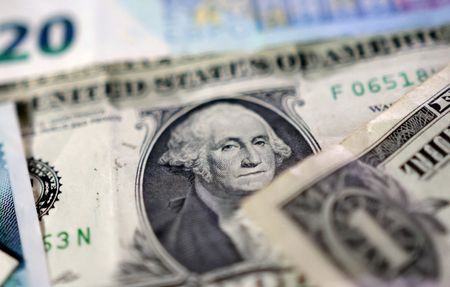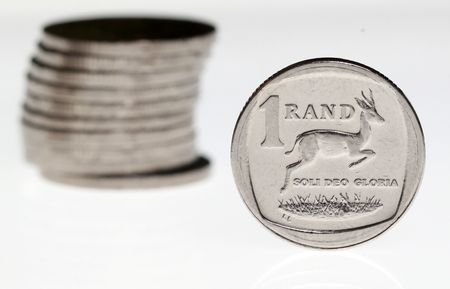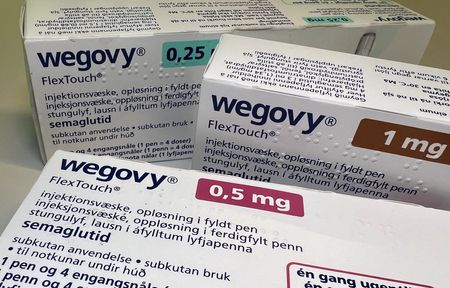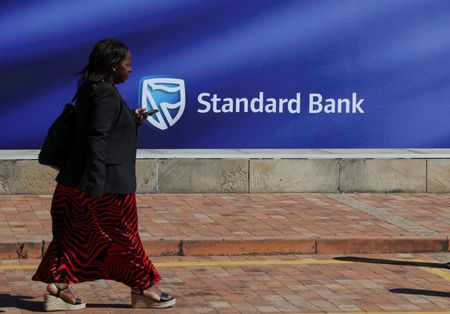By Chibuike Oguh and Naomi Rovnick
NEW YORK/LONDON (Reuters) -Global stocks retreated from record highs on Thursday while U.S. Treasury yields rose after market expectations for an interest rate cut by the Federal Reserve were shaken by stronger-than-expected inflation data.
U.S. producer prices rose 0.9% in July, the Labor Department reported, surpassing consensus forecasts for a 0.2% gain. Investors have been watching for signs of inflation pressures from U.S. President Donald Trump’s trade tariffs.
Wall Street stocks fell, with the benchmark S&P 500 and Nasdaq pulling back from record highs reached on Wednesday. Materials, real estate and industrials stocks were driving losses. Communication services and healthcare stocks were gaining.
The Dow Jones Industrial Average fell 0.38%, the S&P 500 slid 0.25% and the Nasdaq Composite dropped 0.30%.
European stocks held onto gains from earlier in the day and were last 0.49% higher. MSCI’s gauge of stocks across the globe fell 0.37% to 949.56, taking a breather a day after hitting an all-time high.
“We have been too anxious to draw a conclusion that the economy is fine; it’s not overheated,” said Peter Andersen, founder of Andersen Capital Management in Boston. “But this wholesale data does show that perhaps there is some inflation working and we shouldn’t be so quick to conclude, we need to cut interest rates.”
U.S. Treasury yields leaped after the inflation data as expectations for jumbo Fed rate cuts briefly faded. The two-year note yield was last up 5.4 basis points at 3.741%. The benchmark U.S. 10-year note yield rose 5.1 basis points to 4.291%.
Money markets showed traders still almost unanimously expect the Fed to cut borrowing costs next month, although some traders have lowered their bets. Markets are predicting a 92.5% chance that the Fed will cut rates by 25 basis points in September, down slightly from 94.3% on Wednesday but up from nearly 59%, according to the CME FedWatch tool.
“It reinforces the case that the Fed might say we still don’t have a clear picture yet based on the tariffs in the employment picture to take any action and I would expect that they would tend to be neutral and make no change in September as opposed to the majority of opinions out there,” Anderson said.
UK and euro area government bonds sold off alongside Treasuries.
The benchmark 10-year Bund yield was up 50 bps at 2.71% and Britain’s equivalent gilt yield rose 4 bps to 4.643%.
About 70% of global investors expect U.S. stagflation, with growth slowing as consumer price rises accelerate, to become the dominant market narrative within three months, a Bank of America survey found this week.
The dollar rose against major peers after falling in the prior session. It strengthened 0.27% to 147.78 against the Japanese yen and was up 0.39% at 0.808 against the Swiss franc.
The euro fell 0.55% to $1.164. The dollar index tracking the greenback against peers including the euro and Japan’s yen edged 0.6% higher.
Trump on Wednesday threatened “severe consequences” if Russian leader Vladimir Putin did not agree to peace in Ukraine and has also floated the idea of a second summit that would include Ukrainian President Volodymyr Zelenskiy.
Brent crude, the global oil benchmark, rose from almost a two-month low with a 1.7% jump to $66.75 a barrel and U.S. crude added 1.8% to $63.77.
Spot gold fell 0.39% to $3,341.31 an ounce. U.S. gold futures fell 0.66% to $3,336.50 an ounce.
(Reporting by Chibuike Oguh in New York, Naomi Rovnick in London, Jaspreet Kalra in Singapore and Sanchayaita Roy in Bangalore; Editing by Muralikumar Anantharaman, Kim Coghill, Christina Fincher, Amanda Cooper and Richard Chang)











